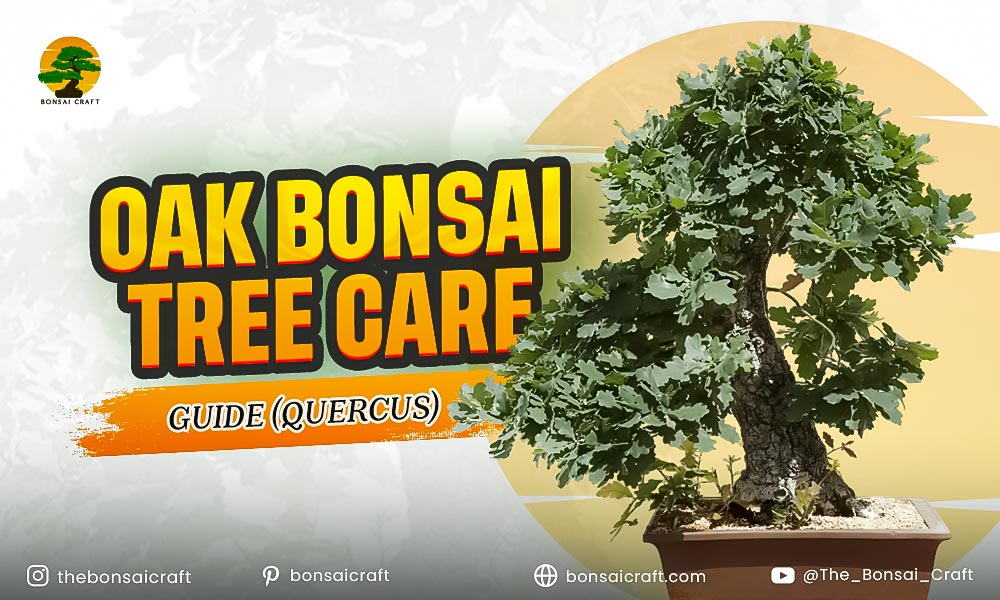
Cultivating an oak bonsai tree is one of the most rewarding experiences for bonsai enthusiasts. Oaks (genus Quercus) are known for their strength, longevity, and majestic beauty. When transformed into bonsai oak trees, they embody both resilience and elegance in miniature form. From red oak bonsai to white oak bonsai, each species offers unique challenges and opportunities for bonsai artists.
As a bonsai grower with years of hands-on experience, I’ve learned that mastering oak bonsai care requires understanding the tree’s natural growth habits, soil needs, watering cycles, and pruning techniques. In this guide, we’ll explore everything you need to know—from how to bonsai an oak tree to when to prune an oak bonsai, ensuring your miniature oak thrives for decades.
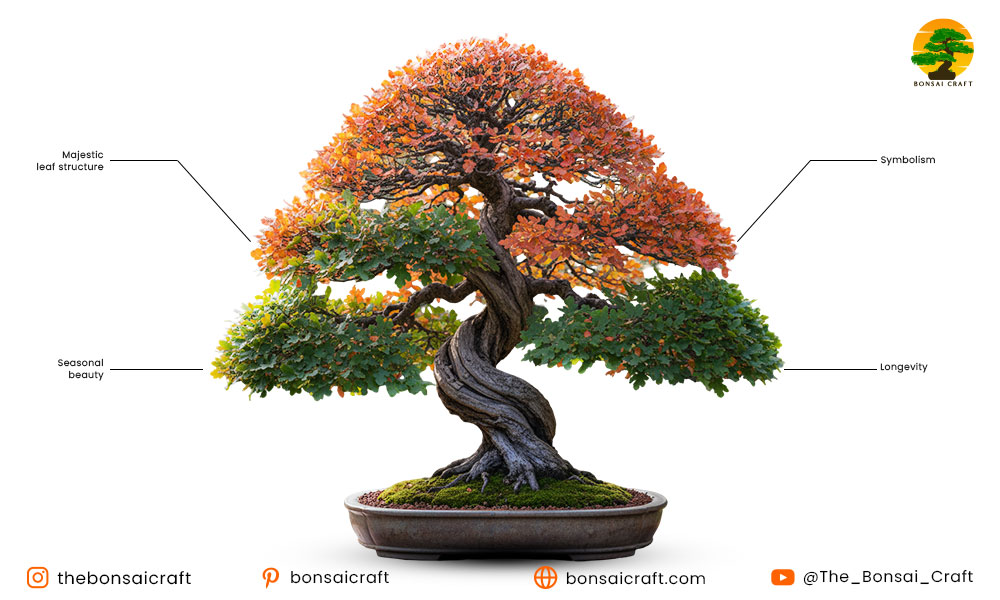
Why Choose an Oak Bonsai Tree?
The bonsai oak is highly valued for its:
- Majestic leaf structure: Oaks have lobed leaves that reduce in size with proper bonsai techniques.
- Seasonal beauty: Oaks showcase vibrant autumn colors and sturdy winter silhouettes.
- Longevity: An oak bonsai tree can live for centuries when properly cared for.
- Symbolism: Oaks represent strength, wisdom, and endurance in many cultures.
Growing an oak bonsai is not just about shaping a tree—it’s about cultivating patience and resilience alongside your bonsai.
Can You Bonsai an Oak Tree?
Yes, you can bonsai an oak tree. Oaks adapt well to bonsai cultivation when grown in proper soil, given enough sunlight, and managed with pruning and root care.
Unlike delicate species, bonsai oak trees are hardy and forgiving, making them suitable for both beginners and advanced bonsai practitioners. However, patience is key, as oaks grow slowly and require long-term commitment.
How to Bonsai an Oak Tree
Creating a bonsai oak tree involves several steps:
- Choose your oak species – Common options include red oak bonsai, white oak bonsai, and live oak (Quercus virginiana).
- Start from a seed, an acorn, or a sapling – Many enthusiasts prefer learning how to grow a bonsai oak tree from an acorn, as it allows full control over training.
- Plant in well-draining bonsai soil – A mix of akadama, pumice, and lava rock ensures oxygen flow and prevents root rot.
- Begin shaping with wiring and pruning – Oaks respond well to bonsai tree trimming and wiring when done at the right season.
- Provide outdoor care – Oaks are outdoor trees that need sunlight, rain exposure, and natural seasonal cycles.
How to Grow a Bonsai Oak Tree from an Acorn
To grow a bonsai oak tree from an acorn, collect fresh acorns in autumn, cold-stratify them for 1–2 months, and plant in well-draining soil. Keep moist and provide sunlight. Once seedlings sprout, begin shaping and root pruning after the first year.
Growing from an acorn allows you to control trunk development and achieve better nebari (surface roots). However, it requires patience—your oak bonsai may take 5–10 years before looking mature.
How to Bonsai an Oak Sapling
To bonsai an oak sapling, start with a young tree 1–2 years old. Prune the taproot during repotting to encourage lateral root growth. Begin trunk training with light wiring, and trim excess branches to establish a basic structure.
Saplings are ideal for beginners who want a head start compared to growing from acorns but still desire long-term shaping opportunities.
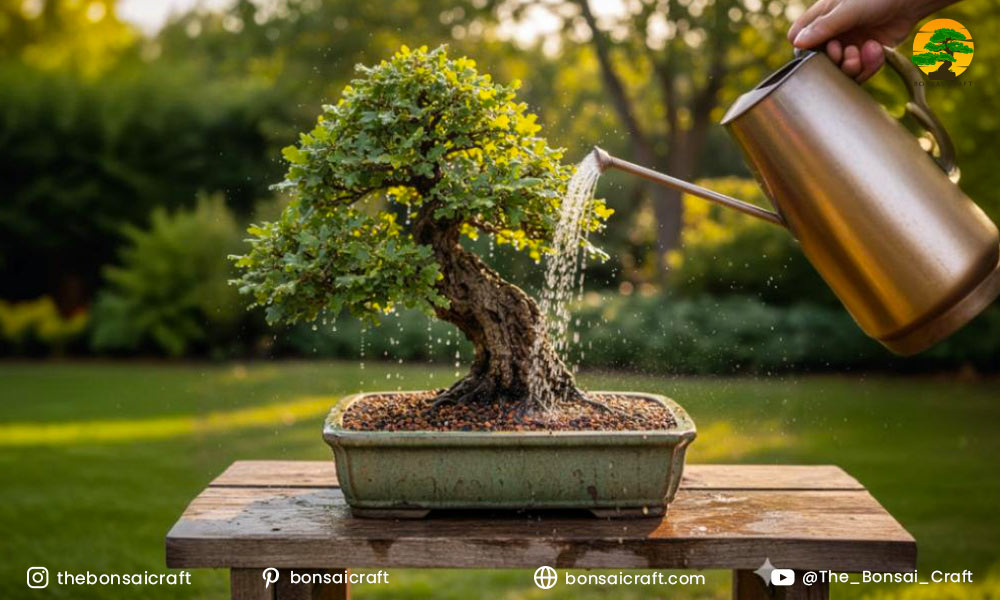
Light and Watering Needs for Oak Bonsai
- Light: Place your bonsai oak tree outdoors in full sun. Oaks require at least 6 hours of direct sunlight daily.
- Watering: Water deeply when the topsoil feels dry. Avoid waterlogging, as oaks dislike soggy roots. In hot summers, daily watering may be necessary.
- Humidity: Oaks adapt well to natural outdoor humidity. If indoors, provide humidity trays or occasional misting.
When to Trim Live Oak Trees and Bonsai Oaks
The best time to trim live oak trees and bonsai oaks is in late winter or early spring, before new growth begins. This reduces stress and promotes healthy back-budding.
For bonsai oak trees:
- Structural pruning: Late winter/early spring.
- Maintenance pruning: Throughout the growing season, remove unwanted shoots and large leaves to encourage smaller foliage.
- Leaf pruning (defoliation): Summer, to promote smaller leaves and denser growth.
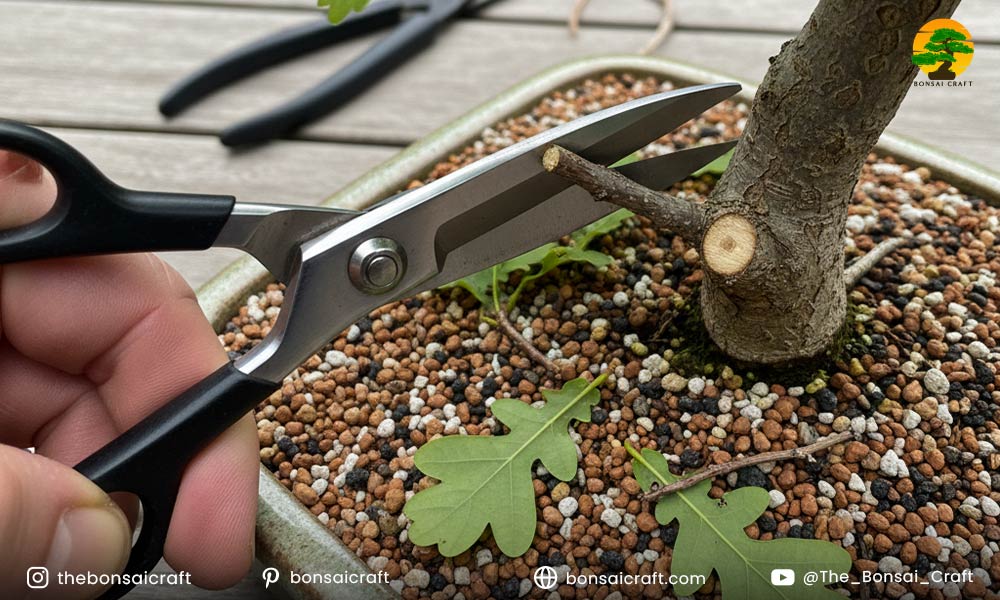
How to Prune an Oak Bonsai Tree
To prune an oak bonsai tree, cut back long shoots to 2–3 nodes, remove crossing branches, and thin out crowded areas to allow light penetration. Use sharp, sterilized bonsai scissors to prevent infections.
Pruning maintains compact growth, enhances ramification (branch splitting), and keeps the oak bonsai proportional. Avoid heavy pruning in summer, as it can weaken the tree.
When to Repot Oak Bonsai
Repot your oak bonsai every 2–4 years in early spring, before buds open. Younger trees require more frequent repotting, while mature oaks can go longer.
Repotting steps:
- Remove old soil and inspect roots.
- Trim thick or circling roots.
- Replant in fresh bonsai soil.
- Water thoroughly and protect from direct sun for 1–2 weeks.
This ensures healthy root growth and prevents root-bound conditions.
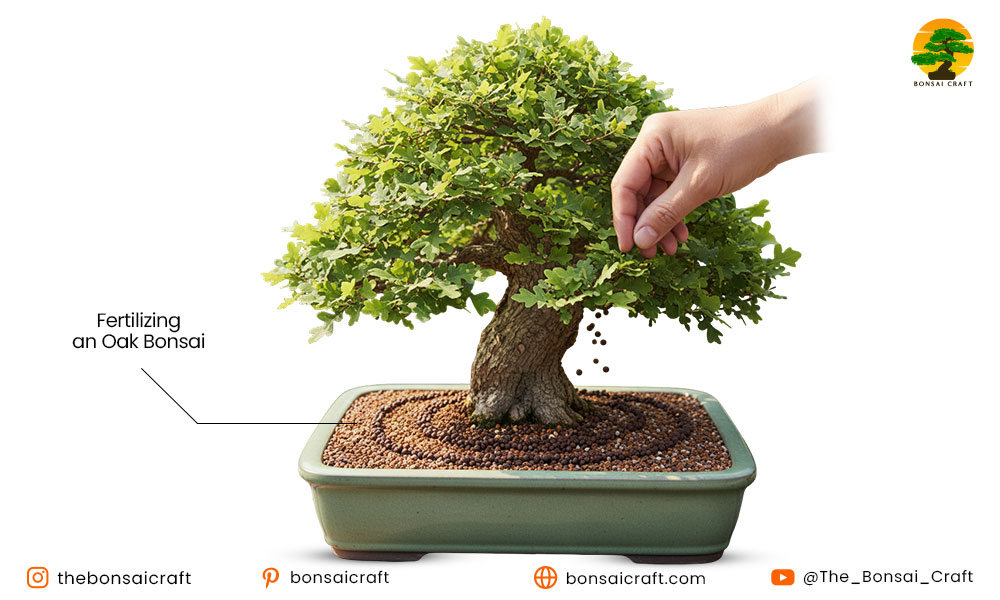
Fertilizing an Oak Bonsai
Fertilizer is crucial for bonsai oak trees, as container soil provides limited nutrients.
- Type: Use organic bonsai fertilizer (pellets or liquid) with balanced NPK.
- Schedule: Feed every 2–3 weeks during the growing season (spring to early autumn).
- Winter care: Reduce or stop fertilization when the tree is dormant.
Avoid over-fertilizing, as this can cause large leaves and reduce the refined bonsai look.
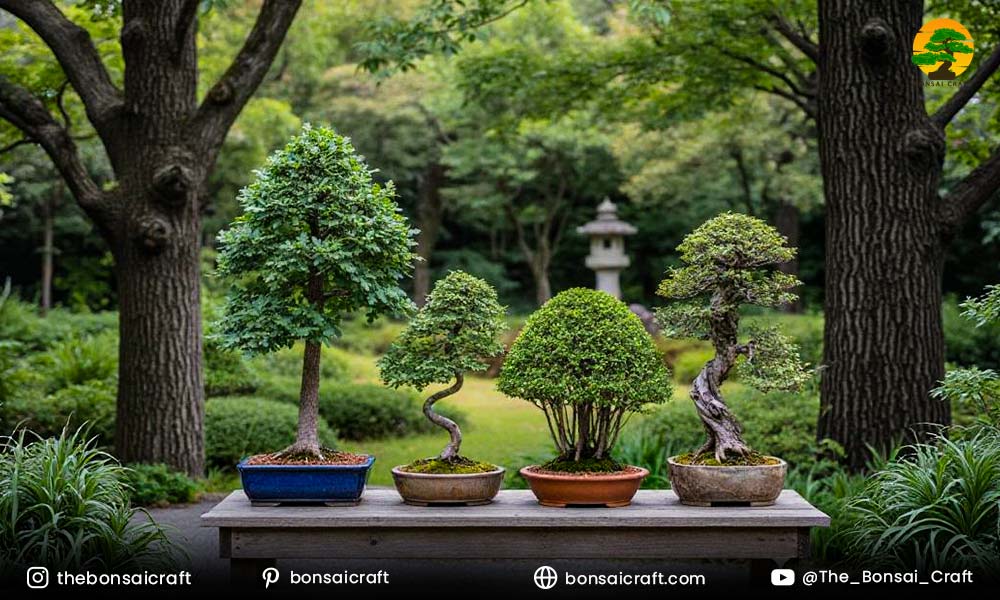
Styling Ideas for Bonsai Oaks
Oaks naturally suit strong, powerful bonsai styles:
- Formal upright (Chokkan) – Highlighting the oak’s straight trunk.
- Informal upright (Moyogi) – Gentle curves with balanced branching.
- Broom style (Hokidachi) – Perfect for white oak bonsai with spreading canopies.
- Naturalistic style – Showcasing oak’s rugged, ancient look.
Wiring can be used for shaping, but since oak wood is brittle, bend branches carefully and slowly.
Common Problems in Oak Bonsai Care
Even hardy bonsai oak trees face challenges:
- Powdery mildew – Common in humid climates; prevent with airflow and fungicide.
- Aphids and scale insects – Treat with neem oil or insecticidal soap.
- Root rot – Caused by poor drainage; always use well-draining soil.
- Leaf burn – From over-fertilizing or lack of water in the summer heat.
Consistent monitoring and preventive care keep your oak bonsai thriving.
Conclusion
The oak bonsai tree (Quercus) is a timeless choice for bonsai lovers who value strength, endurance, and seasonal beauty. Whether you start from an acorn, a sapling, or nursery stock, proper oak bonsai care involves watering, pruning, repotting, and seasonal fertilization.
As someone who has trained multiple bonsai oaks over the years, my expert tip is this: be patient. Oaks grow slowly, but the reward is a bonsai that mirrors the grandeur of ancient oak forests in miniature.
With the right care, your bonsai oak tree can become a living legacy passed down through generations.
FAQs on Oak Bonsai Tree Care
How to grow a bonsai oak tree from an acorn?
To grow a bonsai oak tree from an acorn, cold-stratify acorns for 1–2 months, plant in bonsai soil, and water consistently. Once seedlings sprout, begin pruning and shaping after the first year.
Can I bonsai an oak tree?
Yes, you can bonsai an oak tree. Oaks adapt well to bonsai cultivation when provided with sunlight, proper soil, and regular pruning. Both red oak bonsai and white oak bonsai are excellent choices.
When to prune an oak tree for bonsai?
Prune an oak bonsai tree in late winter or early spring before new growth. Light maintenance pruning can continue throughout the growing season to control shape and size.
How to make an oak bonsai?
To make an oak bonsai, start with an acorn or sapling, prune roots, wire branches, and train the trunk into your desired style. Provide proper watering, fertilization, and repotting for long-term growth.
When to repot oak bonsai?
Repot your bonsai oak tree every 2–4 years in early spring. Young trees may need more frequent repotting, while older specimens can go longer without disturbance.
